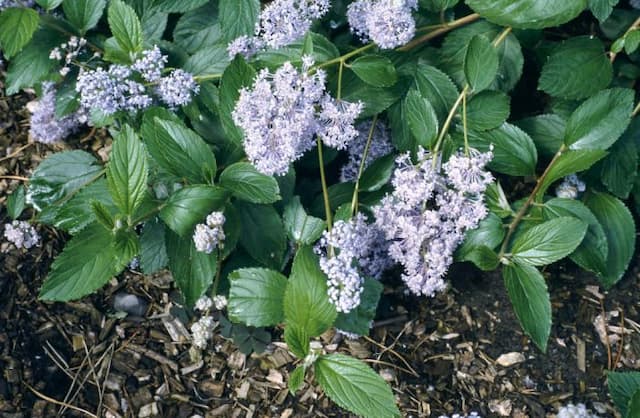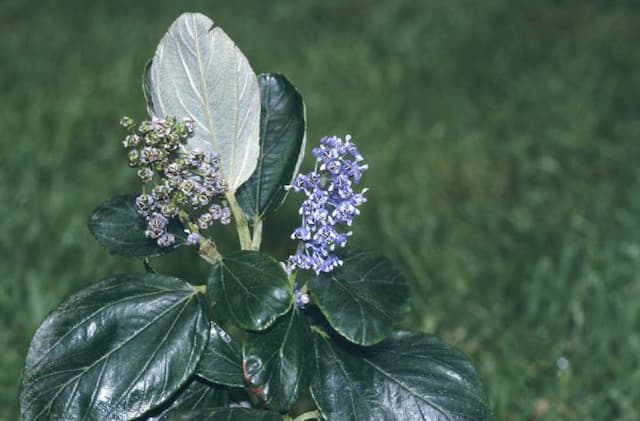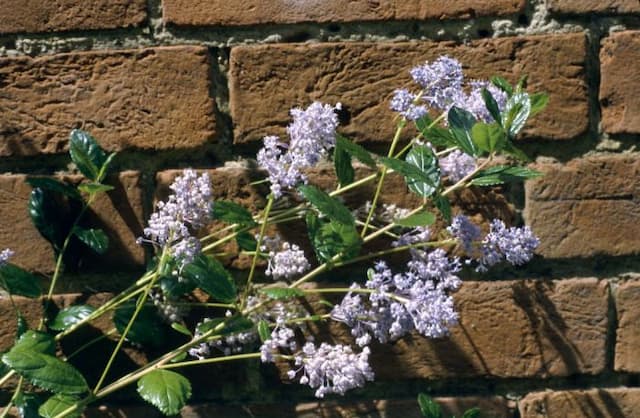California Lilac Ceanothus 'Blue Sapphire' (PBR)

ABOUT
Ceanothus 'Blue Sapphire', commonly known as California Lilac, is an eye-catching shrub recognized for its appealing foliage and stunning flower display. The leaves of this plant are small and oval-shaped, exhibiting a glossy, dark green color, which creates a striking backdrop for its flowers. A distinctive characteristic of 'Blue Sapphire' is the intense blue hue of its blooms, which appear in profuse, fluffy clusters. These vibrant flowers emerge in spring and can cover the shrub, providing a bold splash of color to the garden. The contrast between the luminous blue flowers and the lush greenery of its foliage is particularly notable. Though the size of this variety is not the subject here, it's clear that the plant's vivid floral display makes it a focal point wherever it is grown. The California Lilac, with its resilient nature, can also attract various forms of wildlife, including bees, butterflies, and birds that are drawn to its nectar-rich blooms. The overall look of Ceanothus 'Blue Sapphire' is one of both charm and robustness, capable of bringing a lively and ornamental touch to landscaping projects without consideration of its dimensions.
About this plant
 Names
NamesFamily
Rhamnaceae
Synonyms
California Lilac, Blueblossom, Blue Brush, Wild Lilac
Common names
Ceanothus 'Blue Sapphire' (PBR).
 Toxicity
ToxicityTo humans
California Lilac, commonly known as Ceanothus 'Blue Sapphire', does not have a well-documented profile for toxicity in humans. It is generally not considered to be a poisonous plant to humans. However, as with any plant material, individual allergies or sensitivities might occur. If a person were to ingest part of the plant and experience any unusual symptoms, seeking medical advice would be recommended.
To pets
California Lilac, known as Ceanothus 'Blue Sapphire', is also not listed as a commonly toxic plant to pets, such as dogs and cats. It does not typically pose a serious risk of poisoning if pets were to consume parts of the plant. However, as with any non-food plant, ingestion can sometimes cause minor stomach upset in pets. If a pet is observed to ingest this plant and shows signs of distress or illness, a veterinarian should be consulted.
 Characteristics
CharacteristicsLife cycle
Perennials
Foliage type
Evergreen
Color of leaves
Green
Flower color
Blue
Height
3 feet (0.91 meters)
Spread
5 feet (1.52 meters)
Plant type
Shrub
Hardiness zones
7
Native area
North America
Benefits
 General Benefits
General Benefits- Attractive Flowers: Boasts deep blue blossoms that add vibrant color to gardens and landscapes in spring and summer.
- Drought Tolerance: Once established, it requires minimal watering, making it suitable for dry climate gardens or water-wise landscaping.
- Low Maintenance: Requires little pruning or care beyond the basic, making it a good choice for low-maintenance gardens.
- Pollinator Friendly: Flowers attract bees, butterflies, and other pollinating insects, promoting biodiversity in the garden.
- Evergreen Foliage: Maintains its glossy green leaves throughout the year, providing continuous visual interest.
- Compact Size: Its small, mounded form is ideal for smaller gardens or spaces where a full-sized Ceanothus would be too large.
- Versatility: Can be used in various settings, including borders, containers, rock gardens, and as a ground cover.
- Deer Resistant: Its foliage is typically not favored by deer, making it suitable for gardens in areas with deer populations.
- Fast Growing: Establishes quickly in the garden, providing swift coverage and satisfaction from planting to maturity.
 Medical Properties
Medical PropertiesThis plant is not used for medical purposes.
 Air-purifying Qualities
Air-purifying QualitiesThis plant is not specifically known for air purifying qualities.
 Other Uses
Other Uses- Ceanothus 'Blue Sapphire', commonly known as California lilac, can be used as a natural dye. The flowers may provide a range of blue and purple hues, suitable for dyeing fabrics or yarns.
- The dense, evergreen foliage of California lilac provides excellent cover for small garden wildlife, such as birds and beneficial insects, creating a mini habitat.
- California lilac's wood, being quite hard and fine-grained, can be used for making small wooden objects such as handles, inlays, and crafts requiring durable wood.
- The plant can be incorporated into a sensory garden; California lilac's vibrant blue flowers and textured leaves offer visual and tactile stimuli.
- Ceanothus 'Blue Sapphire' can be used as a living fence or privacy screen due to its dense growth habit, thus providing a natural alternative to artificial barriers.
- The plant is suitable for bonsai creation, thanks to its ability to be pruned and trained into miniature tree forms, showcasing the intricate and delicate structure of the branches and foliage.
- California lilac can be used to stabilize slopes and prevent soil erosion because of its deep root system that helps to secure the ground.
- In coastal areas, California lilac can be planted to act as a windbreak, protecting more delicate plants and reducing soil desiccation by sea winds.
- The flowers of Ceanothus 'Blue Sapphire' may be used in the creation of potpourri mixes, providing a splash of natural color and a subtle fragrance when dried.
- For artistic purposes, the natural form and blooms of the California lilac can be used as a subject for photography and botanical illustration, capturing the beauty of this shrub.
Interesting Facts
 Feng Shui
Feng ShuiThe California Lilac is not used in Feng Shui practice.
 Zodiac Sign Compitability
Zodiac Sign CompitabilityThe California Lilac is not used in astrology practice.
 Plant Symbolism
Plant Symbolism- Hope and Aspiration: The vibrant blue flowers of Ceanothus, also known as California Lilac, symbolize a desire for greater things and aspirations to reach new heights, reflecting the plant's natural vigorous growth.
- Endurance and Longevity: Ceanothus is known for being drought-tolerant, making it a symbol of endurance and the ability to thrive under challenging conditions.
- Patriotism: The blue hue of the California Lilac's flowers can represent loyalty and patriotism, particularly in the United States, where blue is one of the nation's official colors.
- Good Fortune: In some cultures, the abundant and exuberant flowering of the California Lilac is seen as a sign of good fortune and prosperity.
 Water
WaterThe California Lilac should be watered deeply but infrequently, allowing the soil to dry out slightly between waterings. During the growing season, watering once every one to two weeks with about one to one and a half gallons per watering is typically sufficient. Adjustments should be made to account for rainfall, with less frequent watering needed during wet periods. In hot, dry weather, more frequent watering may be necessary. Always check the soil moisture before watering to ensure the plant is not overwatered, as California Lilacs prefer well-drained soil and do not tolerate soggy conditions.
 Light
LightCalifornia Lilacs thrive in full sun conditions where they receive at least six to eight hours of direct sunlight daily. The ideal spot for the plant is in an area with unobstructed exposure to the sun to ensure vibrant blooms and healthy growth. Partial shade is acceptable, but flowering may be reduced.
 Temperature
TemperatureCalifornia Lilacs are hardy and can withstand temperatures as low as 10 to 15 degrees Fahrenheit for short periods, although they perform best in warmer climates where typical temperatures range between 50 to 75 degrees Fahrenheit. The ideal temperature conditions for this plant are mild to warm, avoiding prolonged exposure to freezing temperatures to prevent damage to foliage and stems.
 Pruning
PruningPrune California Lilacs to maintain shape and promote bushier growth. The best time to prune is immediately after flowering to give the plant time to set buds for the next year. Prune back overgrown branches by no more than one-third, and remove any dead or damaged wood. Regular pruning, done annually, will also help to rejuvenate older shrubs.
 Cleaning
CleaningAs needed
 Soil
SoilCalifornia Lilac 'Blue Sapphire' requires well-draining soil with a pH between 5.5 and 7.5. A mix of loam, peat, and coarse sand is ideal to facilitate proper drainage and aeration. It’s important to avoid heavy and waterlogged soils.
 Repotting
RepottingCalifornia Lilac 'Blue Sapphire' rarely needs repotting; do so only if it outgrows the current container. It's best to be repotted every 3-4 years to refresh the soil and provide space for growth.
 Humidity & Misting
Humidity & MistingCalifornia Lilac 'Blue Sapphire' tolerates a wide range of humidity levels but prefers moderate conditions. Humidity around 40-50% is ideal for this plant's well-being.
 Suitable locations
Suitable locationsIndoor
Place in bright light, avoid overwatering, well-draining soil.
Outdoor
Full sun, well-drained soil, protect from severe frosts.
Hardiness zone
7-10 USDA
 Life cycle
Life cycleCeanothus 'Blue Sapphire', commonly known as California Lilac, begins its life cycle with germination, where the seed, under suitable environmental conditions, sprouts and develops roots and shoots. The plant then enters the vegetative stage where it grows leaves, stems, and a root system to absorb water and nutrients while undergoing photosynthesis. This is followed by the maturity stage, where the California Lilac reaches its full size and starts to produce vibrant blue flowers, typically blooming in spring or early summer, attracting pollinators. After pollination, the flowers develop into fruit, which contains seeds that, when matured, are dispersed by various means, including animals and wind. The plant then cycles back to dormancy, often in response to colder temperatures or drought conditions, conserving its resources for the next growing season. This perennial shrub may experience several years of growth and reproduction before eventually reaching the end of its life span and dying, completing its life cycle.
 Propogation
PropogationPropogation time
Spring-Early Summer
Propogation: Ceanothus 'Blue Sapphire', commonly known as California lilac, is typically propagated through semi-hardwood cuttings. The best time to take these cuttings is during mid-summer to early fall. A semi-hardwood cutting is a portion of the plant's stem that has matured partially after the spring growth flush. You would snip a 4 to 6-inch long (about 10 to 15 centimeters) section from a healthy branch, strip the leaves from the lower half, and dip the cut end in rooting hormone powder to encourage root development. Afterward, the cutting is planted in a well-draining soil mix and kept moist until roots develop, a process that can generally take several weeks. It is important to provide a warm environment and avoid direct sunlight during this rooting period to ensure the best chances of propagation success.









